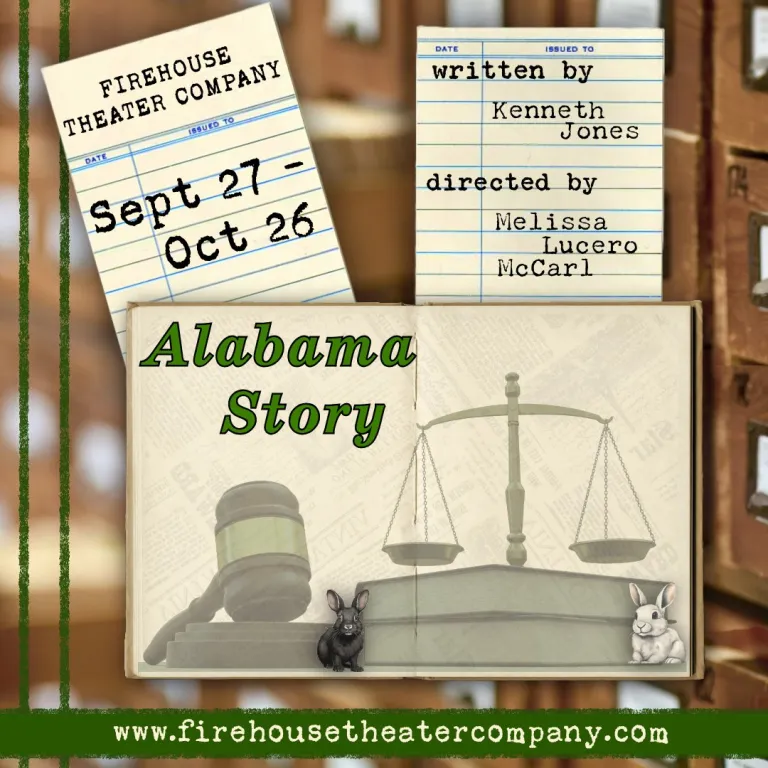Review: Alabama Story
Posted by Curtain Up! on Sep 30, 2025
Review: Alabama Story |Firehouse Theater Company | Denver, CO | Curtain Up! | Eric Fitzgerald | September 30, 2025

The proverbial curtain rises on Alabama Story, and with it, Firehouse Theater Company ignites its 2025–2026 season at the John Hand Theater with a production that refuses to whisper. Kenneth Jones’s taut, unexpectedly hilarious drama—directed with unflinching clarity by Melissa Lucero McCarl—doesn’t just revisit the racial and political tensions of 1950s Montgomery, Alabama; it dares to ask what happens when the ghosts of civic memory are denied their reckoning. It’s the kind of humor that knows exactly how close we are to the edge—and doesn’t baulk.
While librarian Emily Reed (Martha Harmon Pardee) defends The Rabbits’ Wedding—a real children’s book and the center of a censorship scandal in Alabama Story—against Senator E.W. Higgins’s (Matt Hindmarch) crusade to purge “dangerous” ideas from the state’s shelves, a quieter story unfolds between Lilly Whitfield (Elicia Hesselgrave) and Joshua Moore (Jysten Atom), two childhood friends whose reunion forces a reckoning with the past.
Reed’s principled stand for intellectual freedom plays out in public hearings and whispered threats. At the same time, Lilly and Joshua’s relationship—marked by memory, misremembering, and the quiet ache of unfinished conversations—unfolds in the margins. Thomas Franklin (Cal Meakins), Reed’s loyal assistant, offers quiet support, while Garth Williams (Jeff Jesmer), the book’s real-life illustrator, appears as a spectral presence, reminding us that art itself is often the first casualty in a culture war.
Pardee’s Emily Reed is the moral spine of Alabama Story, and she carries that weight with a librarian’s precision—quiet, firm, and deeply human. Her performance doesn’t chase heroism; it earns it through restraint. Reed’s resolve to protect a children’s book from censorship becomes a stand-in for every principled fight waged in silence. Pardee lets us feel the cost of that silence—the loneliness, the doubt, the slow erosion of institutional support. She’s not just defending a rabbit wedding; she’s defending the idea that stories matter, even when they make people uncomfortable.
Others in the cast are on equal footing. As Senator Higgins, Hindmarch, is no mustache-twirling villain—he’s folksy, persuasive, and terrifyingly sure of his moral footing. Meakins as Thomas Franklin, Reed’s assistant, offers a quieter arc: the journey from passive observer to reluctant ally, his nervous energy a mirror for the audience’s own discomfort. In the parallel narrative, Joshua, played by Atom, and Lilly, played by Hesselgrave, grapple with memory and race, their shared past serving as a microcosm of the South’s selective amnesia. Atom’s quiet dignity and Hesselgrave’s aching nostalgia form the emotional undercurrent of the play—a reminder that history isn’t just debated in boardrooms but lived in bodies.
In a standout performance, Jesmer delivers a superlative performance in a variety of characters, but shines in the role of Garth Williams, the illustrator of The Rabbits’ Wedding. His second act opening monologue plays with great intelligence and candor. It is a perfect mix of gentle wit and quiet provocation, delivered with the kind of ease that belies its emotional precision. Jesmer doesn’t just inhabit Garth Williams—he animates the artist’s bewilderment, warmth, and subtle defiance. The monologue becomes a hinge point in the play, where humor and heartbreak meet, and Jesmer’s performance ensures the audience feels both. It’s the kind of moment that reminds us how even the softest voices can stir the loudest echoes. Bravo!
Director McCarl brings Alabama Story to life with a clarity of vision that honors both the play’s historical weight and its emotional nuance. Her direction is precise without being rigid, allowing moments of quiet resistance to bloom alongside bursts of rhetorical fire. McCarl balances the dual timelines with grace, weaving the political and the personal into a seamless tapestry of memory, conviction, and reckoning.
Behind the scenes of Alabama Story—and behind the scenes of our current civic landscape—plays a quieter drama: the battle over historical narrative itself. As debates ripple through school boards, state legislatures, and cultural institutions over curriculum standards, public education funding, and the politicization of civil rights legacies, Jones’s play lands with eerie precision. The characters in Alabama Story wrestle with who gets to tell the story of a community, who gets erased, and who gets remembered. It’s the same question animating today’s tug-of-war over book bans, agency oversight, and the rewriting of civic memory.
Firehouse Theater Company isn’t just opening a season, it’s opening a dialogue we desperately need, staged with the kind of moral clarity and comic grace that feels both urgent and rare. Without resorting to fanfare, it’s fair to say this production stands among one of Firehouse’s most compelling offerings in recent years—thoughtfully cast, sharply directed, and emotionally resonant in ways that linger long after the lights fade. Alabama Story runs through October 26, and it must be seen by everyone with a pulse—and preferably a sense of humor and a conscience.
Information and tickets: https://www.firehousetheatercompany.com/
